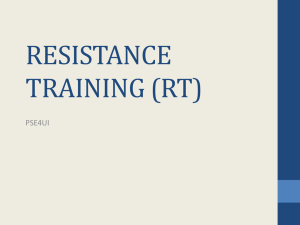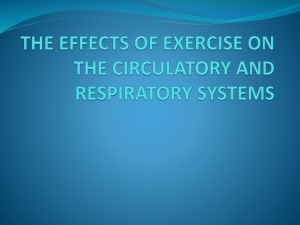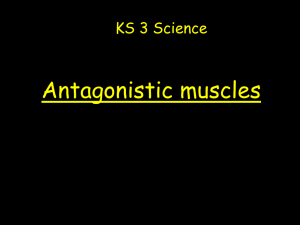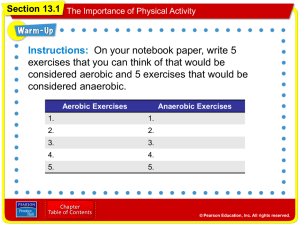word - In the Zone
advertisement
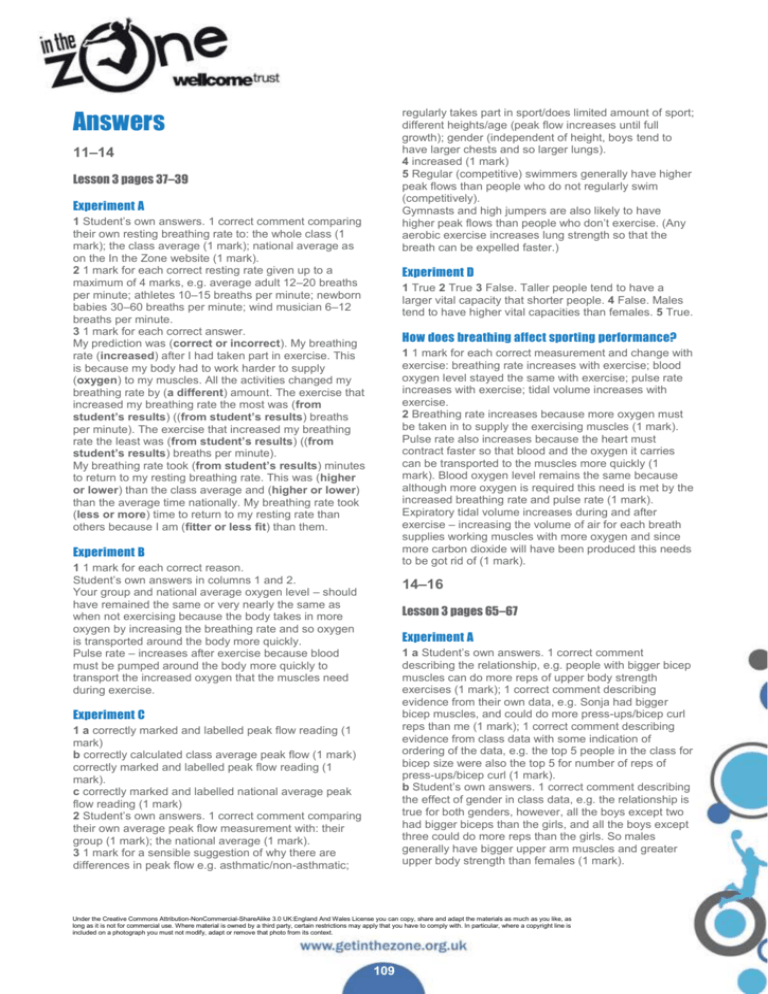
Answers regularly takes part in sport/does limited amount of sport; different heights/age (peak flow increases until full growth); gender (independent of height, boys tend to have larger chests and so larger lungs). 4 increased (1 mark) 5 Regular (competitive) swimmers generally have higher peak flows than people who do not regularly swim (competitively). Gymnasts and high jumpers are also likely to have higher peak flows than people who don’t exercise. (Any aerobic exercise increases lung strength so that the breath can be expelled faster.) 11–14 Lesson 3 pages 37–39 Experiment A 1 Student’s own answers. 1 correct comment comparing their own resting breathing rate to: the whole class (1 mark); the class average (1 mark); national average as on the In the Zone website (1 mark). 2 1 mark for each correct resting rate given up to a maximum of 4 marks, e.g. average adult 12–20 breaths per minute; athletes 10–15 breaths per minute; newborn babies 30–60 breaths per minute; wind musician 6–12 breaths per minute. 3 1 mark for each correct answer. My prediction was (correct or incorrect). My breathing rate (increased) after I had taken part in exercise. This is because my body had to work harder to supply (oxygen) to my muscles. All the activities changed my breathing rate by (a different) amount. The exercise that increased my breathing rate the most was (from student’s results) ((from student’s results) breaths per minute). The exercise that increased my breathing rate the least was (from student’s results) ((from student’s results) breaths per minute). My breathing rate took (from student’s results) minutes to return to my resting breathing rate. This was (higher or lower) than the class average and (higher or lower) than the average time nationally. My breathing rate took (less or more) time to return to my resting rate than others because I am (fitter or less fit) than them. Experiment D 1 True 2 True 3 False. Taller people tend to have a larger vital capacity that shorter people. 4 False. Males tend to have higher vital capacities than females. 5 True. How does breathing affect sporting performance? 1 1 mark for each correct measurement and change with exercise: breathing rate increases with exercise; blood oxygen level stayed the same with exercise; pulse rate increases with exercise; tidal volume increases with exercise. 2 Breathing rate increases because more oxygen must be taken in to supply the exercising muscles (1 mark). Pulse rate also increases because the heart must contract faster so that blood and the oxygen it carries can be transported to the muscles more quickly (1 mark). Blood oxygen level remains the same because although more oxygen is required this need is met by the increased breathing rate and pulse rate (1 mark). Expiratory tidal volume increases during and after exercise – increasing the volume of air for each breath supplies working muscles with more oxygen and since more carbon dioxide will have been produced this needs to be got rid of (1 mark). Experiment B 1 1 mark for each correct reason. Student’s own answers in columns 1 and 2. Your group and national average oxygen level – should have remained the same or very nearly the same as when not exercising because the body takes in more oxygen by increasing the breathing rate and so oxygen is transported around the body more quickly. Pulse rate – increases after exercise because blood must be pumped around the body more quickly to transport the increased oxygen that the muscles need during exercise. 14–16 Lesson 3 pages 65–67 Experiment A 1 a Student’s own answers. 1 correct comment describing the relationship, e.g. people with bigger bicep muscles can do more reps of upper body strength exercises (1 mark); 1 correct comment describing evidence from their own data, e.g. Sonja had bigger bicep muscles, and could do more press-ups/bicep curl reps than me (1 mark); 1 correct comment describing evidence from class data with some indication of ordering of the data, e.g. the top 5 people in the class for bicep size were also the top 5 for number of reps of press-ups/bicep curl (1 mark). b Student’s own answers. 1 correct comment describing the effect of gender in class data, e.g. the relationship is true for both genders, however, all the boys except two had bigger biceps than the girls, and all the boys except three could do more reps than the girls. So males generally have bigger upper arm muscles and greater upper body strength than females (1 mark). Experiment C 1 a correctly marked and labelled peak flow reading (1 mark) b correctly calculated class average peak flow (1 mark) correctly marked and labelled peak flow reading (1 mark). c correctly marked and labelled national average peak flow reading (1 mark) 2 Student’s own answers. 1 correct comment comparing their own average peak flow measurement with: their group (1 mark); the national average (1 mark). 3 1 mark for a sensible suggestion of why there are differences in peak flow e.g. asthmatic/non-asthmatic; Under the Creative Commons Attribution-NonCommercial-ShareAlike 3.0 UK:England And Wales License you can copy, share and adapt the materials as much as you like, as long as it is not for commercial use. Where material is owned by a third party, certain restrictions may apply that you have to comply with. In particular, where a copyright line is included on a photograph you must not modify, adapt or remove that photo from its context. 109 Experiment D 2 a Large upper arm muscles: canoeing, decathlon, gymnastics (e.g. horizontal bar, parallel bar, rings), javelin, rowing, shot put, swimming (1 mark each). Smaller upper arm muscles: 100 m sprint, cycling, dancing, diving, football, gymnastics (for artistic/rhythmic events), judo, table tennis (mainly leg muscles) (1 mark each). b i Student’s own answers. 1 correct comment, e.g. such as biceps, triceps, back, and shoulders; however they will generally not have large lower body muscles; because they have trained those muscles (arms and shoulders) that are important for their sport; because they need high upper body strength; so they can produce more force with each arm stroke and make fast movements by contracting muscles quickly; therefore they will be able to make fast, strong arm movements needed in their sport (1 mark). ii Student’s own answers. 1 correct comment, e.g. such as thighs, calves, and hamstrings; however they will generally not have large upper body muscles; because they have trained those muscles (legs) that are important for their sport; because they need high lower body strength (1 mark). 1 mark for each correct answer. My standing broad jump result was (very similar) before and after performing the bicep curls. Before the bicep curls it was (from student’s results) and after the bicep curls it was (from student’s results). These results (agreed/did not agree) with my prediction. The results show that fatigue in one set of muscles (does not) have an effect on another set of muscles. (Note however that there will probably be some cases where students do get a difference.) 1 1 mark for each correct answer. [100 m sprint] High lower body strength required to move fast [dancing] High lower body strength required to control own body weight while standing on toes or when crouching down (squatting) [cycling] High lower body strength required to produce large force and to raise body weight up steep climbs [rowing] High upper body strength required to produce large force with each arm stroke, and large stroke length [table tennis] High lower body strength required to move fast and maintain crouch position (squatting) [swimming] High lower body strength required to produce large force against a resisting force [shot put] High upper body strength required to lift and throw large weights [judo] High upper body strength required to grip and to pull hard 2 Student’s own answers. 1 mark for each correct observation for each sport (up to 4 marks). For example, Dancing: lower body power needed for vertical jumps (1 mark); lower body endurance needed for repeated squats/crouches over an hour’s performance (1 mark); Judo: lower body power upwards from squat (1 mark) and muscular endurance for fights of 5-10 minutes (1 mark). Experiment B 1 True 2 True 3 False. Most people have stronger lower body muscles because we use our lower body muscles in everyday life to walk and run. 4 False. ... such as swimming, which exercise the upper body muscles. 5 False. People who play sports that require good upper body strength (such as tennis or swimming) can do more press-ups in one minute than people who play sports that require good lower body strength (such as running or rugby). 6 The national data shows that generally males have greater upper body strength than females. Experiment C 1 a Student’s own answers. Correctly calculated class average jump score and number of lunges completed (1 mark). b Student’s own answers. 1 correct comment using class data to describe that is likely to be false (1 mark). 2 1 correct comment explaining that people who are good at the vertical jump test will have a high percentage of fast-twitch muscles and not necessarily a high percentage of slow-twitch muscle fibres, which is needed for the endurance test (lunges). 3 Student’s own answers. e.g. (1 mark for each match with a correct reason) football good at lunges (i.e. endurance) swimming good at lunges (i.e. endurance) hockey good at lunges (i.e. endurance) tennis good at lunges (i.e. endurance) sprinting good at vertical jumps (i.e. power) long distance running good at lunges (i.e. endurance) judo good at vertical jumps (i.e. power) skating good at vertical jumps (i.e. power) cycling good at lunges (i.e. endurance) rugby good at lunges (i.e. endurance) dancing good at vertical jumps (i.e. power) netball good at lunges (i.e. endurance) 16–19 Lesson 3 pages 101–105 Experiment A 1 Subjective – depends on students’ own data 2 Depends on their data – teacher can check that students have substituted values correctly in the appropriate equation. 3 Factors affecting power generated and work done: strength of people’s muscles; flexibility of their joints; stamina and endurance – how long they can do the exercise before tiring; cardiovascular fitness; body composition (muscle-to-fat ratio); how much exercise you do on a regular basis each week; type of exercise you do; genetics – e.g. proportion of slow or fast-twitch muscle fibres; whether hungry or not; previous consumption of alcohol/caffeine; whether on any medication; asthmatic or not; general health (e.g. having a cold). 4 Tiredness, as muscles fatigue due to lactic acid from anaerobic respiration. 110 5 Probably males as they generally have more muscle; people with high muscle-to-fat ratio; slim people; people who exercise regularly. 6 (i) Feel warm, as when muscles need to contract their cells need to increase the rate of respiration to make more ATP. Some energy released from glucose is released as heat. This is carried away from muscle cells, in blood, to be dissipated. (ii) Hence, students may look red-faced or red-skinned in other parts of their body due to vasodilation, when more blood flows near the skin surface to lose heat by radiation. (iii) May also sweat, as this is a method of cooling down – water in sweat on the skin evaporates, taking latent heat from the skin. (iv) The increased rate of respiration produces more carbon dioxide. This enters the blood and flows through an area of the brain (medulla) where the lowered pH is detected. The medulla sends impulses (via the autonomic nervous system) to the (phrenic) nerve supplying the diaphragm to increase the rate and depth of breathing. This flushes out the extra carbon dioxide and brings in more air and hence more oxygen. (v) Legs may begin to ache as muscles fatigue. This may be due to lactic acid from anaerobic respiration and may also be a result of the brain ‘informing’ muscles that they are fatigued. These effects may become more severe as intensity of exercise builds up, although at some point, athletes get a ‘second wind’ and as toxic byproducts are dealt with and extra oxygen is supplied to muscles to meet demand, the task seems easier/less painful. 7 The muscles of your legs need ATP to contract. In the first 2–3 seconds of exercise, this extra ATP is supplied from stored ATP in muscle cells. The ATP is hydrolysed, releasing energy. Another compound stored in muscle, creatine phosphate, can also be broken down to produce ATP. However, these stores are rapidly used up. For about the next 75 seconds (up to 1.5 minutes into the exercise) it is mainly anaerobic respiration that provides the energy. Anaerobic respiration takes place in the cytoplasm of the muscle cells and partially breaks down many molecules of glucose per minute to release energy to make ATP, and lactic acid. At the same time as all of these systems are operating, aerobic respiration also goes on in muscle cells, but at first this is not sufficient to meet the muscles’ demands for energy. After about 2 minutes, when heart rate and breathing rate have increased, the aerobic system provides most of the energy. Lactic acid produced during anaerobic respiration can enter the mitochondria of muscle cells and be directly used in aerobic respiration. Pyruvate from glycolysis, the breakdown of glycogen/glucose in the cytoplasm of muscle cells, also enters mitochondria and is further oxidised. Much ATP is produced. rate will increase as the brain sends more nerve impulses, via the autonomic nervous system, to the sino atrial node of the heart. This has the effect of delivering more oxygenated blood to the skeletal muscles more quickly and of removing carbon dioxide and lactic acid from muscle cells more quickly. The lowered pH of muscle tissue (due to increased carbon dioxide or lactic acid from the increased rate of respiration) and the increased temperature of muscle tissue (due to increased heat released from the increased rate of respiration) shift the oxygen dissociation curve to the right. This lowers the affinity of haemoglobin for oxygen so that oxygen dissociates from haemoglobin more readily in the muscles. The venous blood leaving the muscles may therefore contain less oxygen then when we are at rest, but the pulse oximeter measures arterial oxygen levels. At normal altitudes, these levels are always likely to be high. 5 They need to see if they get similar ratings from the three different methods. VO2max is likely to be more accurate (nearer to the true value) than the other two methods, but these are perhaps easier and quicker. All three methods are a good way of estimating an athlete’s aerobic fitness, as exercise needs muscle contraction, which needs ATP, which is generated by respiration; aerobic respiration needs oxygen, which is delivered by the cardiovascular system to muscles. Hence, any indirect measure of the body’s increased use of oxygen or increased efficiency of circulation is a good way of assessing an athlete’s fitness/effectiveness of a training programme. Students could note that a direct measurement of oxygen consumption (and hence an accurate measurement of VO2max) is only possible if athletes run on a treadmill or cycle on an exercise bike in a lab while having their oxygen consumption and carbon dioxide production measured by gas analysis, for example using a Douglas bag. Students could consider what factors are likely to alter the results they get from each fitness test, such as tiredness; whether hungry or not; previous consumption of alcohol/caffeine; whether on any medication; asthmatic or not; general health (e.g. having a cold); also age and genetics. 6 They probably did not exercise as hard as they could, which is why they scale their rate of oxygen consumption during exercise by the percentage of their maximum heart rate. In sports physiology labs athletes usually exercise to exhaustion, but this is more time consuming, not pleasant, and could be dangerous in this experiment as we do not know the fitness levels of students. If the rate of stepping or the height of the bench had been increased, students’ heart rate would have increased further and they would be working nearer their maximum rate of oxygen consumption (VO2max), but probably still sub-maximal. 7 The step is the same size for students of all heights, so taller people or people with long lower limbs use less energy to step a fixed height. This means they will not have to work so hard, their heart rate will be lower, and VO2max is underestimated. Experiment B 1, 2 and 3: Depends on students’ own data – teacher can check they have substituted data correctly in the formulae. 4 Heart rate should increase after exercise. Arterial oxygen saturation level probably will not change. Heart 111 8 There are many ways of measuring fitness. For aerobic fitness: • resting heart rate – someone who has good cardiovascular fitness has a high stroke volume so at rest, to achieve normal cardiac output, they have a low resting pulse rate. However, some people who are not fit have bradycardia – an abnormally slow heart rhythm. • recovery time – shorter time taken for pulse rate to return to normal after exercise indicates good cardiovascular fitness. • resting blood pressure – if within the 110–120/70–80 mm Hg, indicates good cardiovascular health. • VO2max is the most accurate way to estimate cardiovascular fitness. It measures how well the heart and lungs deliver oxygen to muscles and how well the muscles use the oxygen. However to do this properly requires exercise to exhaustion (such as the bleep test). Other ways of measuring fitness include: • strength – many athletes are assessed on how much weight they can lift, to indicate the strength of their arm muscles. Press-ups, sit-ups, and vertical jumps also indicate muscle strength. • power – a vertical jump can indicate the explosive power of leg muscles. • flexibility – head turning can assess flexibility of the neck. Sitting on the floor with legs flat out in front of you, then stretching arms and fingertips towards your toes also assesses flexibility. • endurance – repeating an exercise, such as press-ups or pull-ups, to see how long it takes before you tire. • size – waist-to-hip ratio can indicate fat distribution of the body. Muscle size can also be measured – e.g. biceps and/or thigh circumference. • bone density can indicate strength • BMI (body mass index) or just body mass. This is a rough guide as it does not give an indication of muscle-to-fat ratio, so a very muscular athlete could appear to be overweight. Skin callipers can indicate percentage body fat, but some people appear thin but have fat stored around their internal organs rather than subcutaneously. Body fat composition can be assessed by Bioelectrical Impedance Analysis – a low level electric current is passed through the body and its impedance is measured. However, subjects need to be at a particular level of hydration so must not eat or drink 4 hours before the test and must not drink alcohol or take diuretics for 48 hours before the test. In all of these tests, age needs to be taken into consideration. 9 Most athletes/sportspeople in training take some of the above measurements at intervals to monitor how effective their training programme is and to see if they are improving. Some of these measurements are also important as health indicators for the general population. For example, resting blood pressure (high values indicate a risk of heart disease or stoke), resting pulse rate (high values indicate a risk of heart attack due to the heart working harder all the time), BMI/body mass (extra weight puts a strain on the heart, joints, and back), bone density (if too low it indicates risk of osteoporosis), flexibility (we all need, for example, to bend to pick things up, turn heads when driving to see traffic), waist/hip ratio (being apple-shaped is more of a risk for heart disease than being pear-shaped as being appleshaped increases risk of diabetes), endurance (being able to walk briskly for 12 minutes as age increases improves wellbeing and can help prevent back pain). 10 Training increases cardiovascular fitness. It increases heart size with thickening of the left ventricle wall, so its contraction is more powerful. It increases stroke volume and cardiac output, and reduces resting heart rate and resting blood pressure. It increases tidal volume, vital capacity, and the rate at which maximum uptake of oxygen is reached. Training strengthens other muscles and increases their power – it leads to increased size of muscle fibres; increased number and size of mitochondria; increase in glycogen and fat stored in muscles; increased quantities of respiratory enzymes; increased amount of myoglobin (an oxygen store) in muscles. Training also improves utilisation of fat as a respiratory substrate, balance, coordination, and flexibility, and strength of ligaments, tendons, and bones. Experiment C 1 Depends on students’ own data. It is likely that they will expect less carbon dioxide in their breath after the intense/anaerobic exercise compared to the less intense/aerobic exercise, because they know that anaerobic respiration produces lactic acid and no carbon dioxide. 2 At rest there is some aerobic respiration going on in muscle cells. After aerobic exercise, the rate of aerobic respiration will increase so more glucose molecules will be respired per minute and more carbon dioxide will be produced. Some students may refer to where the carbon dioxide is produced (Krebs cycle and link reaction). 3 A short burst of intense exercise will use the anaerobic system to boost ATP production, and this involves partial breakdown of glucose to pyruvate in the cytoplasm and then to lactate, which then diffuses into blood capillaries. No carbon dioxide is produced as an immediate result of this reaction. However, there is a reaction between sodium hydrogen carbonate in the blood and lactate to produce sodium lactate and carbonic acid, which then dissociates into water and carbon dioxide, which is carried in blood to the lungs to be breathed out. Although more carbon dioxide is produced during anaerobic exercise than at rest, there is a short delay before the carbon dioxide produced is breathed out. If the exercise is less intense and aerobic then the amount of carbon dioxide in breath will increase as explained in answer to question 2. 4 Measuring volume of sodium hydroxide solution: human error and systematic errors in the pipette. Errors in making up the 0.1 M solution of sodium hydroxide solution. Determining the end-point is subjective. This can be made easier by holding a white card behind the solution to judge colour change, but subjectivity would be removed if colorimetry were to be used. Mistakes may be made in counting the number of breaths. Some electronic counting device would reduce this error. Students may also specify other valid sources of error. 112 6 A blood pressure within this range indicates good blood flow/less resistance to blood flow in the arteries, which indicates lack of atheromatous plaque and a reduced risk of heart disease or stroke. 7 How quickly blood pressure returns to baseline may depend on the aerobic or cardiovascular fitness level of the individual. A short recovery time indicates good cardiovascular fitness. Good cardiovascular fitness may depend on the individual’s body mass or body mass index, the amount of exercise they do regularly, genetic makeup, diet (less fat, less salt), and whether or not they smoke or drink alcohol. Other methods of measuring carbon dioxide could be to use a different indicator that is also sensitive to small amounts of carbon dioxide (hydrogencarbonate indicator solution), or to use a pH sensor/probe and data logger. 5 This would indicate more clearly whether aerobic respiration is increasing (as indicated by a greater rate of oxygen uptake). Scientists can use this information to design training programmes that have the right balance of aerobic and anaerobic exercise, depending upon the event they are training for. It could also tell us about the type of respiratory substrate being used – e.g. fat or protein as opposed to glucose, as the respiratory quotient could be calculated. How does the body respond to changing energy needs? 1 This will be different perhaps for each of them. They may notice that their heart rate increases more when exercising intently, to remove the lactic acid and to dissipate heat. They may feel warmer and fatigue more quickly when exercising anaerobically. Recovery time after intense exercise may be longer than after less intense exercise. 2 Aerobic: e.g. marathon running, any running of a distance more than 1500 m; swimming over a distance greater than 800 m; cycling; cross-country skiing. Anaerobic: e.g. shot put; javelin throw; high jump; long jump; discus throw, sprinting e.g. 100 m, 200 m. 3 Both require the anaerobic and aerobic systems to be ‘fine-tuned’, and both need strong muscles, bones, and tendons; flexibility; and good general health. So all training programmes will involve exercises like skipping, sit-ups, press-ups, possibly some swimming, and walking and running (varying amounts). Athletes also need to pay attention to their diet and habits (alcohol/tobacco) and they work with their trainers/coaches to develop the programme that suits their needs. They may work in different training zones – see Knowledge Card and PowerPoint slides. To train for aerobic events, athletes develop the aerobic system to enable their body to use oxygen and deal with lactate by long duration but low-intensity cardiovascular exercises such as long runs/skipping/cycling at 60–80% of maximum heart rate. To train for anaerobic events, athletes obviously train the specific muscles but also develop the anaerobic system to raise anaerobic (lactate) threshold by short duration, high-intensity (80– 90% of maximum heart rate) exercises. 4 Depends on their data and how athletic individual students are. 5 Depends on their data and accept any sensible suggestion for reasons. Experiment D 1 This depends on each student’s data. The expected difference between gentle (low-intensity), aerobic exercise and high-intensity anaerobic exercise is that they may fatigue more quickly with intense anaerobic exercise; their pulse rate may increase more than when doing less intense exercise; with longer-lasting, less intense aerobic exercise, they may get a ‘second wind’ and not feel fatigued. Recovery time after intense exercise may be longer than after less intense exercise. 2 It is not possible to measure blood pressure more often than once every 5 minutes, so the recovery time must be estimated by interpolating between measurements made every 5 minutes. 3 While the exercise was being carried out, the body may be in ‘oxygen deficit’. Muscle cells will have used stored oxygen from myoglobin and the haemoglobin in red blood cells will have delivered up more of its oxygen. There will be more carbon dioxide and lactic acid produced. If the heart rate stays high after exercise finishes, blood with the toxic by-products is carried away more quickly to the liver or lungs, to be breathed out (carbon dioxide) or recycled (lactic acid). The increased blood flow to muscles will also re-oxygenate the myoglobin. As a greater volume of blood per unit time is leaving the muscles and returning to the heart in the vena cava, this stretches the heart wall and causes it to contract more powerfully (Starling’s law), increasing systolic blood pressure. 4 Teacher to check they have plotted graph correctly 5 If the athlete stops pedalling suddenly, their systolic blood pressure may drop too quickly and not enough blood would reach the head/brain. A ‘cool down’ or ‘warm down’ as it is usually called (as it is not to do with body temperature dropping) means the systolic pressure returns to normal more slowly and the brain is not suddenly deprived of oxygen. 113




